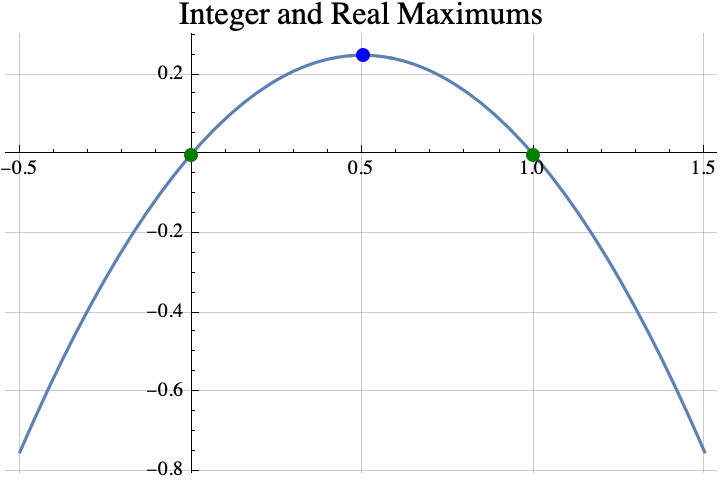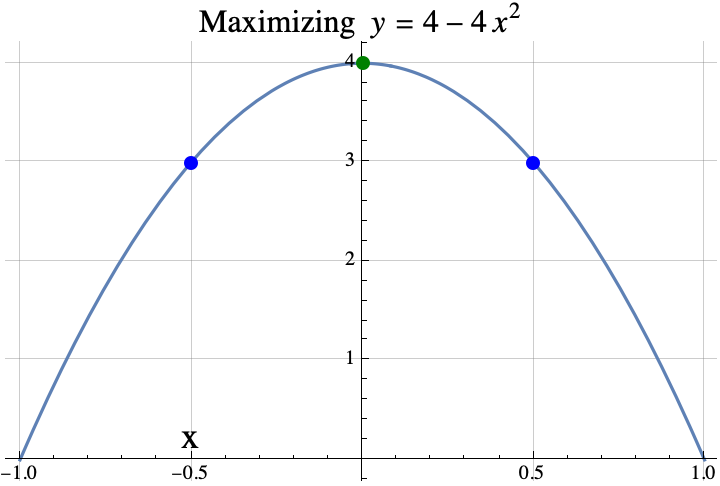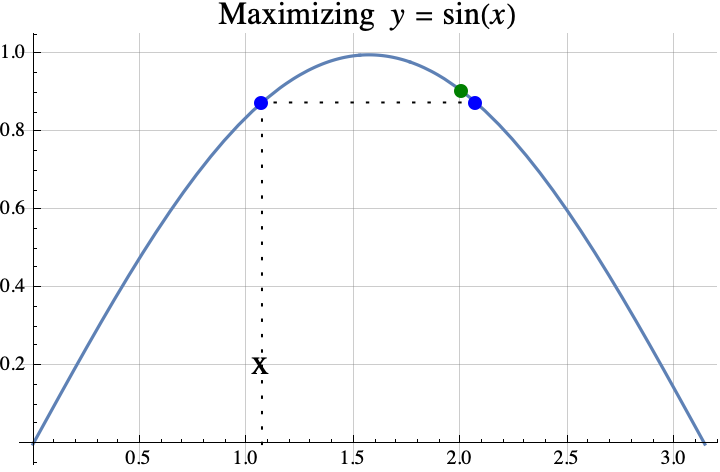This note just reviews the derivation of portfolios that maximize the Sharpe ratio.
Suppose that you have some stocks that you want to invest in. We will think of the returns of these stocks as being a random column vector $G$ in $R^n$. Suppose that $r=E[G]\in R^n$ is a vector of the expected return of the stocks and $C= E\left[ (G-r) (G-r)^T\right]$ is the covariance matrix of $G$ with the superscript $T$ indicating the transpose, thus $C\in R^{n\times n}$.
We will often want to maximize the Sharp ratio of a portfolio which is defined as the expected return of the portfolio minus the risk free return divided by the standard deviation. In order to simplify the math a little, we will assume that the risk free return is 0 and $C$ is positive definite, $a^T C a>0$ for all vectors $a\in R^n\setminus\{0\}$. Thus for our purposes, the Sharpe ratio for an “allocation vector” $a\in R^n\setminus\{0\}$ will be defined $$\rho(a) := \frac{E[a^T G]}{\sqrt{E[ (a^T G - a^T r)^2]}} = \frac{a^T r}{\sqrt{a^T C a}}.$$ We could say that the allocation vector is in dollars, so $a_1$ would be the dollar value of the stocks held in the portfolio for the first stock. The value of $a_1$ could be negative indicating that the stock was shorted.
It is helpful to notice that the Sharpe ratio does not change if we double or triple the amount invested in each stock. In fact, for any real number $\gamma\neq 0$ and any nonzero allocation vector $a\in R^n$, $$\rho(\gamma a)= \gamma \rho(a).$$ So, when maximizing $\rho$ we can restrict ourselves to vectors $a$ where $a^T C a=1$.
The matrix $C$ is real symmetric positive semidefinite, so it has a Cholesky decomposition $C=U^T U$ where $U$ is upper triangular. Let $u= U a$. Then $$1=a^T C a= a^T U^T U a = u^T u= ||u||^2, $$ so $u$ has norm 1. Thus if we want to maximize $\rho(a)$, it suffices (by restricting to vectors $a$ where $a^T C a=1$) to maximize $$\rho(a) = \frac{a^T r}{\sqrt{a^T C a}} = a^T r = u^T U^{-T} r$$ over all unit vectors $u$. (We use $U^{-T}$ to denote $(U^T)^{-1}$, the inverse transpose of $U$.) The unit vector which maximizes $u^T U^{-T} r$ is simply $$u^*= \frac{U^{-T} r}{|| U^{-T} r||}.$$ We can now generate an optimal allocation vector $a^*$ by
$$ a^* = U^{-1} u^*= \frac{U^{-1} U^{-T} r}{|| U^{-T} r||} = \frac{ (U^T U )^{-1} r}{|| U^{-T} r||} = \frac{ C^{-1} r}{|| U^{-T} r||}.$$ The scalar factor $|| U^{-T} r||$ has no effect on $\rho$, so $$a^{**} = C^{-1} r$$ is also an optimal allocation vector. Note that the Sharpe ratio of $a^*$
$$\rho(a^{**})=\rho(a^*)=\frac{(a^{*})^T r}{\sqrt{(a^{*})^T C a^*}}=(a^{*})^T r= \frac{r^T U^{-1} U^{-T} r}{|| U^{-T} r||}= || U^{-T} r||.$$
Example 1
Suppose that you want to invest in two uncorrelated stocks. Assume that their expected returns are $r=( 0.001, 0.001)^T$ and their covariance matrix is $$C=\left(\begin{matrix} 10^{-4} & 0 \\ 0 & 10^{-4}\end{matrix}\right).$$ All optimal allocations $a$ of the stocks are multiples of $$a^{**} = C^{-1} r = \left(\begin{matrix} 10^{4} & 0 \\ 0 & 10^{4}\end{matrix}\right)( 0.001, 0.001)^T= (10, \ 10)^T.$$ This merely indicates that the optimal Sharpe ratio is attained if and only if you invest the same amount in money in each of these stocks.
EXAMPLE 2
Suppose that you want to invest in two uncorrelated stocks. Assume that their returns are $r=( 0.001, 0.0005)^T$ and their covariance matrix is $$C=\left(\begin{matrix} 10^{-4} & 0 \\ 0 & 10^{-4}\end{matrix}\right).$$ All optimal allocations $a$ of the stocks are multiples of $$a^{**} = C^{-1} r = \left(\begin{matrix} 10^{4} & 0 \\ 0 & 10^{4}\end{matrix}\right)( 0.001, 0.0005)^T= (10, \ 5)^T.$$ This indicates that the optimal Sharpe ratio is attained if and only if you invest the twice as much money in the first stock and a nonzero amount of money is invested. Note that Kelly Criterion often indicates that your bets should be proportional to the edge of your investments, so it gives similar advice.
EXAMPLE 3
Suppose that we have two gamblers. The first gambler is willing to give you 2.2 times your wager if candidate A wins the election, but you lose the bet if candidate A does not win. (I.e. if you wager $\$10$ with the first gambler, the your net gain will be $\$22 – \$10 = \$12$ if you win.) The second gambler is willing to pay you twice your bet if candidate B wins and you lose your bet with the second gambler if candidate B loses.
This could be called an arbitrage situation.
Let’s assume that there is a 50% chance that candidate A will win and a 50% chance that candidate B will win. We can think of each gambler as being a stock that we can invest in. The expected value of the first gambler is 0.1 (i.e. if you wager ${\$}10$ with the first gambler, your expected net gain is 0.1*${\$}10$ = ${\$}1$.) The expected value of the second gambler is 0. The covariance matrix requires some computations.
$$C_{11} = E[ (G_1-r_1)^2] = 1/2 ( (1.2 – 0.1)^2 + (-1 – 0.1)^2 ) = 1.21.$$
$$C_{12} = C_{21} = E[ (G_1-r_1)(G_2-r_2)] = 1/2 ( (1.2 – 0.1)(-1) + (-1 – 0.1)1 ) = -1.1.$$
$$C_{22} = C_{21} = E[ (G_2-r_2)^2] = 1/2 ( (-1)^2 + (1)^2 ) = 1.$$ $$C = \left(\begin{matrix} 1.21 & -1.1 \\ -1.1 & 1 \end{matrix}\right).$$
Interestingly, $C$ is not invertible. This is because $(10, 11) C (10, 11)^T = 0$. This means that if you wager $\$10$ with gambler 1 and $\$11$ with gambler 2, you will always win $\$1$. If candidate A wins, then you gain $\$12$ from the first gambler and lose $\$11$ to the second. If candidate B wins, then you lose $\$10$ to the first gambler and gain $\$11$ from the second. Since you always win $\$1$, your volatility is zero and your Sharpe ratio is infinite. In the derivation, we assumed that $C$ was positive definite, but in this example, it is not.
In a future post, I would like to give a few more examples and maybe even compare the optimal Sharp ratio allocation with a Kelly allocation.





